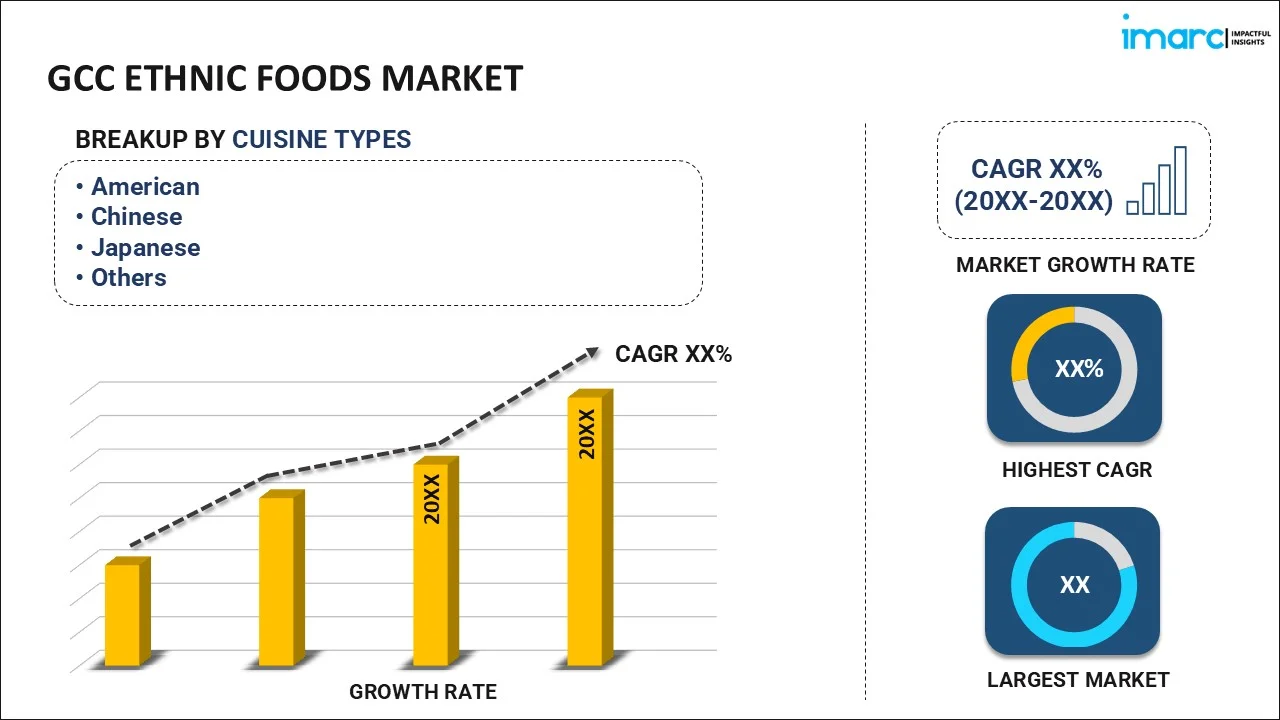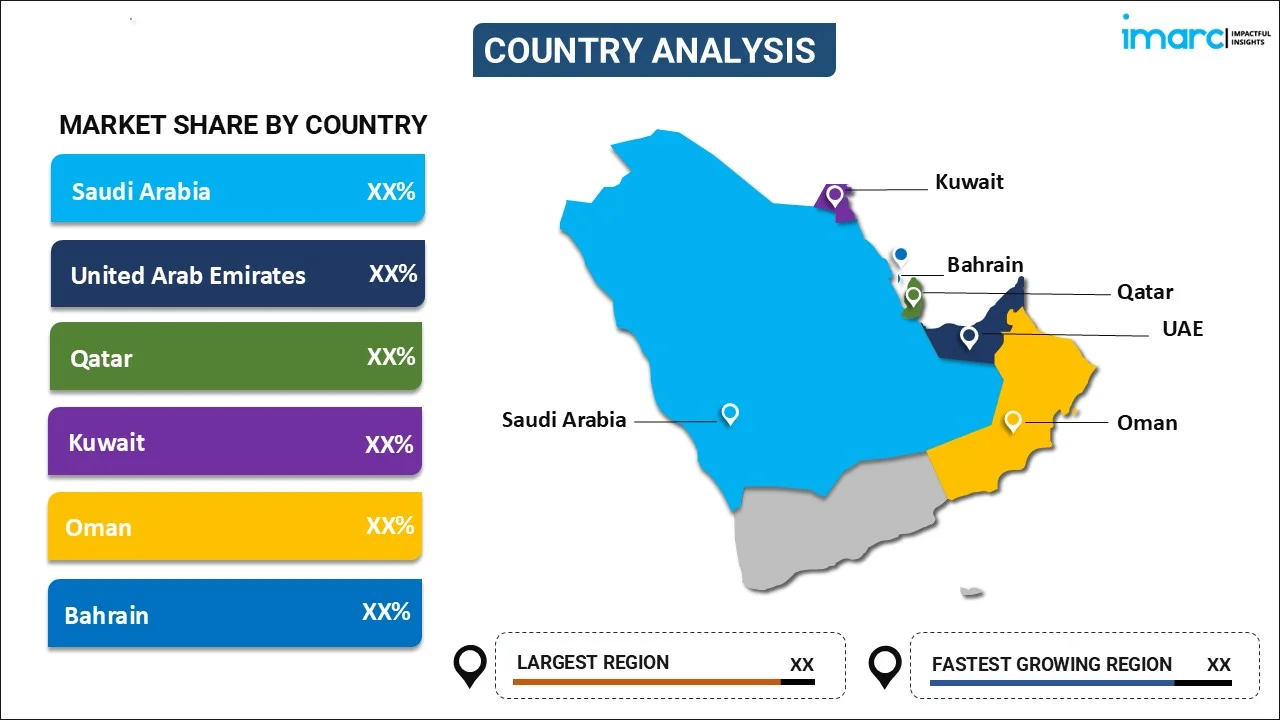
GCC Ethnic Foods Market Report by Cuisine Type (American, Chinese, Japanese, Mexican, Italian, and Others), Food Type (Vegetarian, Non-Vegetarian), Distribution Channel (Food Services, Retail Stores), and Country 2025-2033
Market Overview:
The GCC ethnic foods market size reached USD 934.4 Million in 2024. Looking forward, IMARC Group expects the market to reach USD 2,149.8 Million by 2033, exhibiting a growth rate (CAGR) of 9.3% during 2025-2033. The presence of cosmopolitan demographics, rising travel and tourism activities, rapid urbanization and increasing disposable income, implementation of various initiatives and policies by regional governments, and expanding hospitality and food service sectors represent some of the key factors driving the market.
|
Report Attribute
|
Key Statistics
|
|---|---|
|
Base Year
|
2024 |
|
Forecast Years
|
2025-2033
|
|
Historical Years
|
2019-2024
|
| Market Size in 2024 | USD 934.4 Million |
| Market Forecast in 2033 | USD 2,149.8 Million |
| Market Growth Rate (2025-2033) | 9.3% |
Ethnic foods refer to culinary dishes that are specific to a particular culture or region, embodying unique flavors, cooking methods, and traditional ingredients. It includes Arabian, Mexican, Persian, Indian, Japanese, Chinese, Italian, and Mediterranean, each marked by distinct flavors, textures, and aesthetics. Ethnic foods comprise various ingredients, such as rice, meats, herbs, spices, cheese, beans, lentils, sauces, mushrooms, vegetable oils, and dairy products indigenous to the region. They are rich in carbohydrates, proteins, dietary fibers, healthy fats, vitamins, antioxidants, omega-3 fatty acids, potassium, calcium, iron, magnesium, and zinc. Ethnic foods find extensive applications across daily meals, festive occasions, street food, fine dining, cultural events, hospitality services, travel catering, healthcare institutions, educational facilities, corporate dining, packaged foods, culinary tourism, fusion cuisine, and specialized restaurants. They aid in preserving cultural identity, culinary diversity, introducing international flavors, satisfying varied taste preferences, catering to dietary needs, promoting culinary arts, and enhancing gastronomic experiences.
GCC Ethnic Foods Market Trends:
The presence of cosmopolitan demographics, with an amalgamation of different cultures and nationalities, is boosting the market growth in the GCC region. Furthermore, the rising travel and tourism activities is facilitating the demand for ethnic foods as travelers seek authentic local and international culinary experiences. Additionally, rapid urbanization, rising disposable income, and willingness to explore novel dining options, are contributing to the market growth. Along with this, the implementation of various initiatives and policies by the regional government to promote cultural exchange, tourism, and local businesses is positively influencing the market growth. Moreover, the burgeoning hospitality and food service sectors comprising restaurants, hotels, and catering services are acting as another growth-inducing factor. Apart from this, the widespread adoption of digital platforms for food delivery and online marketing, which expand the consumer base, enhance comfort, and increase accessibility to ethnic foods, is supporting the market growth. In addition, the escalating health consciousness, and the preference for natural, organic ingredients in regular diets is supporting the market growth. Besides this, the continuous innovation, experimentation, and fusion of ethnic foods to meet evolving consumer tastes is fueling the market growth. Furthermore, the presence of international food chains and global culinary events fostering cross-cultural acceptance and providing new market avenues is strengthening market growth.
GCC Ethnic Foods Market Segmentation:
IMARC Group provides an analysis of the key trends in each segment of the GCC ethnic foods market report, along with forecasts at the regional and country levels for 2025-2033. Our report has categorized the market based on cuisine type, food type, and distribution channel.
Cuisine Type Insights:

- American
- Chinese
- Japanese
- Mexican
- Italian
- Others
The report has provided a detailed breakup and analysis of the market based on the cuisine type. This includes American, Chinese, Japanese, Mexican, Italian, and others.
Food Type Insights:
- Vegetarian
- Non-Vegetarian
A detailed breakup and analysis of the market based on the food type has also been provided in the report. This includes vegetarian and non-vegetarian.
Distribution Channel Insights:
- Food Services
- Retail Stores
A detailed breakup and analysis of the market based on the distribution channel has also been provided in the report. This includes food services and retail stores.
Country Insights:

- Saudi Arabia
- UAE
- Qatar
- Bahrain
- Kuwait
- Oman
The report has also provided a comprehensive analysis of all the major regional markets, which include Saudi Arabia, UAE, Qatar, Bahrain, Kuwait, and Oman.
Competitive Landscape:
The report has also provided a comprehensive analysis of the competitive landscape in the market. Competitive analysis such as market structure, key player positioning, top winning strategies, competitive dashboard, and company evaluation quadrant has been covered in the report. Also, detailed profiles of all major companies have been provided.
GCC Ethnic foods Market Report Coverage:
| Report Features | Details |
|---|---|
| Base Year of the Analysis | 2024 |
| Historical Period | 2019-2024 |
| Forecast Period | 2025-2033 |
| Units | Million USD |
| Scope of the Report | Exploration of Historical and Forecast Trends, Industry Catalysts and Challenges, Segment-Wise Historical and Predictive Market Assessment:
|
| Cuisine Types Covered | American, Chinese, Japanese, Mexican, Italian, Others |
| Food Types Covered | Vegetarian, Non-Vegetarian |
| Distribution Channels Covered | Food Services, Retail Stores |
| Countries Covered | Saudi Arabia, UAE, Qatar, Bahrain, Kuwait, Oman |
| Customization Scope | 10% Free Customization |
| Post-Sale Analyst Support | 10-12 Weeks |
| Delivery Format | PDF and Excel through Email (We can also provide the editable version of the report in PPT/Word format on special request) |
Key Questions Answered in This Report:
- How has the GCC ethnic foods market performed so far and how will it perform in the coming years?
- What has been the impact of COVID-19 on the GCC ethnic foods market?
- What is the breakup of the GCC ethnic foods market on the basis of cuisine type?
- What is the breakup of the GCC ethnic foods market on the basis of food type?
- What is the breakup of the GCC ethnic foods market on the basis of distribution channel?
- What are the various stages in the value chain of the GCC ethnic foods market?
- What are the key driving factors and challenges in the GCC ethnic foods market?
- What is the structure of the GCC ethnic foods market and who are the key players?
- What is the degree of competition in the GCC ethnic foods market?
Key Benefits for Stakeholders:
- IMARC’s report offers a comprehensive quantitative analysis of various market segments, historical and current market trends, market forecasts, and dynamics of the GCC ethnic foods market from 2019-2033.
- The research study provides the latest information on the market drivers, challenges, and opportunities in the GCC ethnic foods market.
- Porter's five forces analysis assist stakeholders in assessing the impact of new entrants, competitive rivalry, supplier power, buyer power, and the threat of substitution. It helps stakeholders to analyze the level of competition within the GCC ethnic foods industry and its attractiveness.
- Competitive landscape allows stakeholders to understand their competitive environment and provides an insight into the current positions of key players in the market.
Need more help?
- Speak to our experienced analysts for insights on the current market scenarios.
- Include additional segments and countries to customize the report as per your requirement.
- Gain an unparalleled competitive advantage in your domain by understanding how to utilize the report and positively impacting your operations and revenue.
- For further assistance, please connect with our analysts.
 Inquire Before Buying
Inquire Before Buying
 Speak to an Analyst
Speak to an Analyst
 Request Brochure
Request Brochure
 Request Customization
Request Customization




.webp)




.webp)












